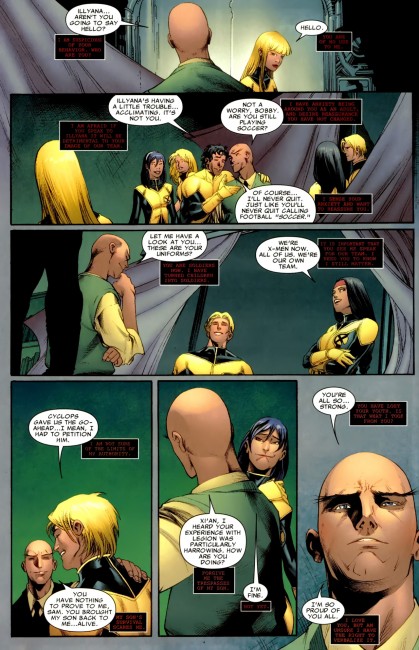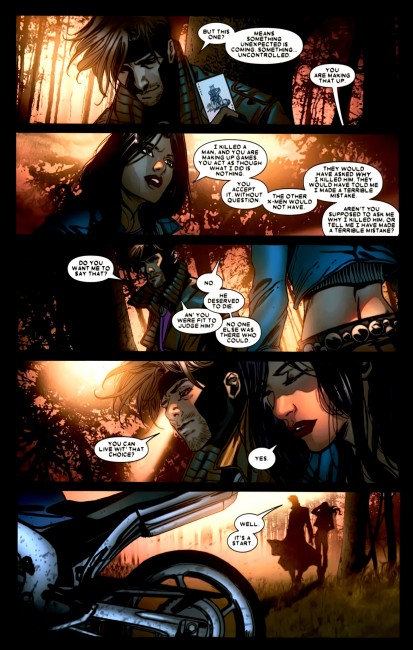
The Children Are The Future (and X-Men is for the babies)
January 13th, 2011 by david brothers | Tags: marjorie liu, new mutants, zeb wellsHere’s a couple of bits from X-Men comics I dug, mainly for their writing.
First bit’s from New Mutants, Vol. 2: Necrosha, with words by Zeb Wells and art by Diogenes Neves. I really dig Wells’s work in general and his work on New Mutants in specific, but this trade is such a mixed bag. As soon as Wells sets up what was clearly meant to be his second arc (the soon-ending New Mutants: Fall of the New Mutants
), he has to write a few tie-in issues to Necrosha (a crossover I did not read) and Kieron Gillen interrupts to clean-up some crap from Siege (a crossover I did not like). The switchover from regular New Mutants to Necrosha was pretty smooth, and the story was good, but the overall picture of v2 is that it’s a hodgepodge. I thought New Mutants, Vol. 1: Return of Legion
was a really strong book, too. The ship was righted after all this crossover crap wrapped, but man. Ugly business. Death to events.
Anyway, here’s one page from a Necrosha issue. It’s from the POV of a recently revived Doug Ramsey, whose mutant power is that he listens well. Or understands every language ever. Unsurprisingly, his mutant power didn’t protect him from being shot and killed years ago. Wells introduced a neat twist on his powers in this issue, and hopefully the red on black text (why?) is legible.

I like this, because it makes what’s honestly a pretty crappy power for adventure stories into something interesting. He can decipher what they mean, rather than what they’re saying. He can also now “read” other things, from cities to computer programs, but this was the bit I liked the best. Wells nailed the characterization here, and I particularly like how Sam Guthrie and Bobby Dacosta come off. I’ve liked those guys since I was a kid and high on that Nicieza/Capullo X-Force. Clever work.
Next is X-23 4, words by Marjorie Liu and art by Will Conrad and Marco Checchetto. Colors by John Rauch. I think this page is Checchetto, but don’t quote me. I picked up the first issue because Marjorie Liu is a pretty ill writer, but I was left pretty underwhelmed. The “Wolverine is in Hell. Hell! HELL!” stuff that’s spread across the Wolverine family of books right now is a huge drag, and that first issue wasn’t really for me. 4 was the start of a new arc, and actually feels like where the series should have begun. It’s much better than before, though I’m still not feeling the art. I think that may be due more to Rauch’s colors, though. He makes stuff seem really washed out, sort of like how Pete Pantazis did on JLA a while back. We’ll see how it shakes out.

I think the “Heroes don’t kill!” thing in comics is dumb, and have harped on it ad nauseam. I like this bit, though, because it’s more… honest. X-23 is a character who has gone from killer to child prostitute and back around to being a killer again. Only this time, she’s a Wolverine-style killer, where it’s hyped up and encouraged until someone decides it isn’t cool. And that always rubbed me the wrong way, like the guy who rails about how drugs are for idiots but is down to hit a blunt at a party. Which is it? Pick one and stick with it.
This, though, is a more honest treatment than the either/or that infests cape comics. It’s just, “You did this thing. Can you live with it?” “Yes, he deserved to die.” “Well, all right.” I like that. When your mutant power is “kills people real good,” a different approach from your usual superheroic code of honor is required. Here, the killing isn’t treated as something positive, or something to be encouraged, but it is treated as necessary, or maybe even just. More like this, please.

While I completely agree that the Siege New Mutants issue really doesn’t fit in with that run, it wasn’t just ‘cleaning up some crap from Siege,’ but rather serving as another chapter of Gillen’s mostly excellent run on Thor (which also branched out into the excellent Siege Loki one-shot). Cash grab? Sure. Worth reading as part of the partly Siege-related story it actually belongs to (thanks to Gillen maneuvering within the admittedly broken system)? Yes. Not to mention the always lovely Henrichon art.
I’m glad they brought Doug Ramsey back and that’s an interesting expansion of his powers. I thought he was underused, because while his ability to decipher any language has fascinating real world possibilities, they’re harder to work into a stories about things blowing up or being punched.
Personally, in our current Information Age where images and words can travel around the planet in an instant, I think Doug Ramsey would be the most dangerous mutant alive. Why? Because he would intuitively know what to say, show, or do to influence people, without using mind control. He could make you trust him by speaking to anyone on their own level. He would know what emotional buttons to push to inflame passions or soothe them. He would be a natural born leader who could walk into a barber shop in Atlanta or fit right in at a party in the Hamptons. He would know how to speak to either group in a way that was completely unforced. He could feel what a crowd needed to hear to rally them to action or tell a kid about to face off with Magneto for the first time exactly what they needed to hear. Like Zeb Wells demonstrated, Doug Ramsey would also be a human lie detector, but he’d probably also have the smoothest game around.
– JEP
Re: the “heroes don’t kill” thing, I always thought the X-Men were usually more explicit about taking their enemies off the board in permanent fashion. That may come from the “threatened species fighting for survival” thing, but in the hands of the better X-Men writers, it can be a tool to interrogate what people who define themselves as “the good guys” are or aren’t prepared to do in extremis.
There was that one hilarious moment back in the 80s where Rachel Summers was out to kill Selene (you know, the lady that lives forever via sucking people’s lives out and killing them) and Wolverine attempted to fatally shank her for it under “X-men don’t kill.” A reminder: this is Wolverine talking. Another reminder: he prevented Rachel from doing this by attempting to kill her.
This proceeded to get even more stupid when Selene drained out a couple random bystanders ONE ISSUE LATER because she needed the energy.
You’re absolutely right about Wells. He’s a reason to get out of X-Bed in the X-Morning.
Great point by Mr. Potts, but to elaborate, Ramsey’s initial power was limited to the spoken word (from what I can remember). Since his resurrection by Celene, his power has been boosted to allow him to be able to interpret all forms of information. Body language, intent, basically the premise of the Cal Lightman character in Lie To Me taken to the nth degree.
I do like where Potts takes this, basically making Ramsey a non-telepathic telepath; letting him see to the truth of the matter and allow him the possibility of manipulating an interaction based off of these nonverbal reads. Excellent insight.
@Drakyn: Yeah, although even back in the ’80s, the X-Men weren’t exactly consistent with their “do not kill” policy.
Personally, though, I’m glad most superheroes don’t kill. Even in comics where problems are mostly solved through fighting, I think that’s their one saving grace. Besides, I bet the average Marvel citizen would be a lot more afraid of superheroes if they did kill people. I know I’d get creeped out if the “real-life superheroes” that appear on the news every now and then start killing in the name of “justice.”
Also, killing would probably get superheroes arrested, both in the real world and in the Marvel Universe (remember the times the cops have tried arresting the Punisher for killing criminals?). And I kind of doubt they’d would want to spend their free time in a court room explaining why killing Villain X counts as self-defense.